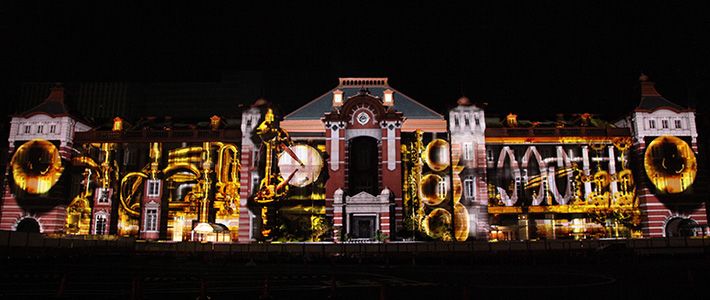
Tokyo Station Becomes a Screen of Dreams
Guideto Japan
Society Culture- English
- 日本語
- 简体字
- 繁體字
- Français
- Español
- العربية
- Русский
Almost 100 years have passed since Tokyo Station was first unveiled in the heart of the modern city. On September 22–23, 2012, a state-of-the-art sound and light show, “Tokyo Station Vision,” was held to mark the station’s official reopening after renovation work to restore the famous red-brick Marunouchi building to its original appearance. Approximately 10,000 people turned up to watch.
The newly restored red brick façade of the station building served as a giant outdoor screen. High-definition computer graphics making full use of the newest "projection mapping" technology were projected onto the huge red brick canvas: a display space some 120 meters long and 30 meters tall, drawing cheers and applause from the spellbound crowd.
“Projection mapping” involves producing visual special effects by projecting images onto a building or other three-dimensional object. In recent years, projection mapping has become a favorite technique in cutting-edge advertising and art installations. Its use in the opening ceremony of the 2012 London Summer Olympics brought the technique to the attention of millions of people around the world. With its remarkable ability to transform familiar buildings, towns, and landscapes into giant screens, many people believe that projection mapping has the potential to become a major new medium for entertainment in the future.
The thousands of people who crowded the streets in front of the station were treated to a spectacular 10-minute computer-generated program featuring giant steam locomotives billowing smoke and a stunning fireworks display. The constantly shifting designs that danced across the surface of the station façade formed a stunning visual introduction to the history of the station and made clear the continuities with its present and future.
The show was put together by five of Japan’s leading young video directors: Nishigōri Isao, Tsuchiya Takafumi, Shiga Takumi, Nagasoe Masatsugu, and Hariu Yūji. Handling the music was Iwasaki Taisei, who has produced scores for numerous films including the 2011 hit Moteki (released overseas as Love Strikes!). Using a total of 46 ultra high-brightness projectors, this was the largest projection mapping show ever in Japan.
Reconstruction work on the Tokyo Station Marunouchi building began in 2007. The project restored the north and south domes, destroyed in an air raid during World War II, and brought the roof and interior of the station back to the way they looked when the station was originally constructed. Structural improvements were also made, including a new underground seismic isolation system. The Marunouchi building is one of only a few large red-brick stations anywhere in the world. Following the recent reconstruction, Tokyo Station now retakes its rightful place along St. Pancras in London and Amsterdam Centraal as a high-convenience twenty-first century railway station with the façade of an earlier time.
Photo Courtesy of JR East
Video by Ōtani Kiyohide (Nippon.com)
tourism culture Society Tokyo Station Marunouchi Japan Railway JR East train